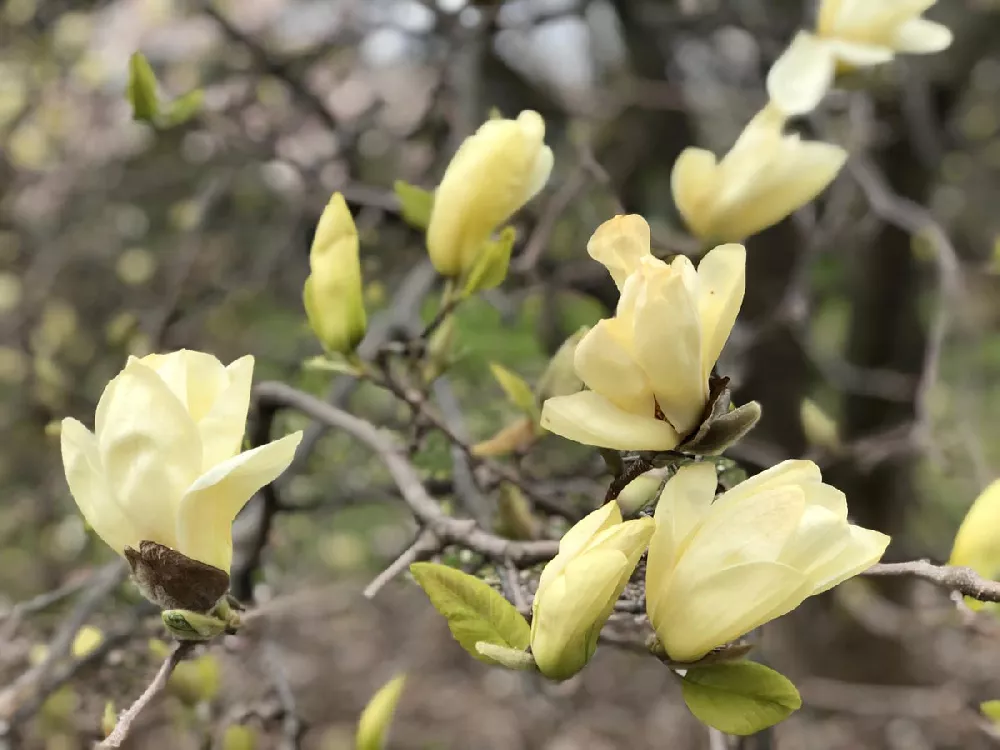The butterfly magnolia tree (Magnolia x ‘Butterflies’) truly lives up to its name with an incredible display of large, fragrant, canary-yellow blooms in spring that resemble a flock of giant butterflies hovering among the branches. When fully mature, this is one of the most breathtaking flowering trees you can grow
Mature Size and Habit
-
A full-grown butterfly magnolia reaches a height of 20-30 feet tall with a spread of 15-20 feet wide. It has an upright, pyramidal form that provides dappled shade below.
-
It can be grown as a single-trunk small tree or allowed to form a multi-stemmed shrub. Either way, it makes a dramatic focal point in the spring landscape.
-
The emerging leaves are a fresh green and provide a nice backdrop for the bright yellow blooms. In fall, the leaves turn yellow adding seasonal interest.
The Spectacular Spring Flowers
-
The butterfly magnolia is prized for its incredibly showy spring bloom, Each flower lasts about a week and has 10-16 tepals (petal-like structures) forming a tulip shape
-
The lemon-scented flowers emerge a rich golden-yellow color before the leaves appear. They cover the bare branches, creating a cloud of sunny blooms.
-
Flowering occurs in mid-spring. On a mature specimen, hundreds of blooms open simultaneously for maximum impact.
-
The flowers contrast beautifully against the gray bark. Flower color ranges from bright yellow to pale yellow or cream depending on cultivar.
Growing Conditions
-
Butterfly magnolias thrive in full sun to partial shade. They tolerate heat, humidity, pollution and wind once established.
-
They prefer consistently moist, organically rich, slightly acidic soil but adapt to average conditions. Avoid soggy wet soils.
-
Established trees have moderate drought tolerance. Mulch and irrigate regularly the first few seasons after planting.
-
Protect flowers from late spring frosts which can damage buds. Shelter from harsh winter winds in cold climates.
Size Management
-
These are fast growing magnolias, adding 1-2 feet of growth per year once established.
-
Prune after flowering is complete to control size and shape. Thin out inner branches on mature trees to allow good air flow.
-
Can be kept smaller with annual summer pruning. Less frequent pruning results in larger size.
-
Remove crossing or damaged branches anytime. Disinfect pruners between cuts.
Landscape Uses
-
The butterfly magnolia steals the spring show as a stand-alone specimen in a front lawn or to anchor a border.
-
Effective as a patio tree where the early flowers can be enjoyed up close. Provides dappled shade in summer.
-
Groupings of three together make a dramatic statement and extend the flowering display.
-
Works nicely in foundation plantings, provided it has room to reach full size. Site carefully.
-
Plant near entries or walkways where the fragrant blooms can be appreciated.
Common Pests and Diseases
Magnolias are generally hardy, trouble-free trees but may be affected by:
-
Scale insects – Control with horticultural oil or insecticidal soap spray.
-
Leaf spots – Improving air circulation reduces fungal disease. Remove and destroy affected foliage.
-
Canker – Avoid wounding bark. Keep trees healthy. Cut out infected areas.
When shopping for a butterfly magnolia, select a tree grafted on Magnolia macrophylla rootstock for best results. This flowering specimen tree offers outstanding ornamental qualities with its enormous yellow “butterfly” blooms clothing the bare branches in spring. Give it plenty of space to allow it to reach its full mature size and enjoy the spectacular floral show each year.
Cottage Farms Magnolia Butterflies Tree on QVC
FAQ
How big does a butterfly magnolia tree get?
|
Soil Type
|
Well Drained
|
|
Drought Tolerance
|
Semi
|
|
Mature Height
|
15-20 Feet
|
|
Mature Width
|
10-15 Feet
|
|
Growth Rate
|
fast
|
- The Ultimate Guide to Growing Strawberries in Raised Beds - August 8, 2025
- No-Dig Garden Beds: The Easiest Way to Grow a Beautiful Garden - August 6, 2025
- How to Protect and Preserve Wood for Raised Garden Beds - August 6, 2025

